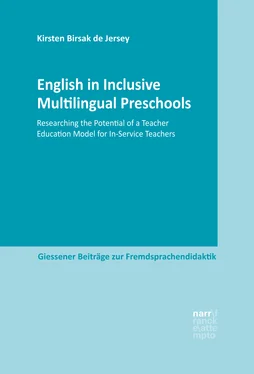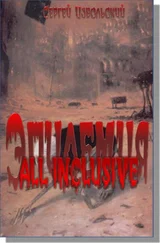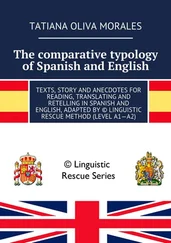Kirsten Birsak de Jersey - English in Inclusive Multilingual Preschools
Здесь есть возможность читать онлайн «Kirsten Birsak de Jersey - English in Inclusive Multilingual Preschools» — ознакомительный отрывок электронной книги совершенно бесплатно, а после прочтения отрывка купить полную версию. В некоторых случаях можно слушать аудио, скачать через торрент в формате fb2 и присутствует краткое содержание. Жанр: unrecognised, на английском языке. Описание произведения, (предисловие) а так же отзывы посетителей доступны на портале библиотеки ЛибКат.
- Название:English in Inclusive Multilingual Preschools
- Автор:
- Жанр:
- Год:неизвестен
- ISBN:нет данных
- Рейтинг книги:3 / 5. Голосов: 1
-
Избранное:Добавить в избранное
- Отзывы:
-
Ваша оценка:
- 60
- 1
- 2
- 3
- 4
- 5
English in Inclusive Multilingual Preschools: краткое содержание, описание и аннотация
Предлагаем к чтению аннотацию, описание, краткое содержание или предисловие (зависит от того, что написал сам автор книги «English in Inclusive Multilingual Preschools»). Если вы не нашли необходимую информацию о книге — напишите в комментариях, мы постараемся отыскать её.
English in Inclusive Multilingual Preschools — читать онлайн ознакомительный отрывок
Ниже представлен текст книги, разбитый по страницам. Система сохранения места последней прочитанной страницы, позволяет с удобством читать онлайн бесплатно книгу «English in Inclusive Multilingual Preschools», без необходимости каждый раз заново искать на чём Вы остановились. Поставьте закладку, и сможете в любой момент перейти на страницу, на которой закончили чтение.
Интервал:
Закладка:
A concluding chapter 8 will finally discuss the results of the study and will structure it following the questions that are related to the research focus of the teacher education study. This includes: the effectiveness of the teacher education model for the sample case including the integration of reflective approaches (→ chapter 8.1); the transfer potential of the teacher education project to other preschool education contexts including a reflection of the required adaptations that a transfer would involve (→ chapter 8.2); a reflection of the research design of the teacher development as participatory action research and presentation of results in the form of a multiple case study (→ chapter 8.3). Reported experiences documented in the literature will be integrated here and future research directions outlined.
2 Relevance of introducing English in preschool
2.1 Research on early language learning
This chapter will argue why it is worthwhile to introduce English at the preschool level. To do so it will clarify who qualifies as a young learner, will reflect on the issue of language choice and will summarize the arguments that have been put forward in favour of an early start in language learning.
Young learners
When reviewing international publications on research related to young learners there is an enormous variation from country to country. Ellis (2014) notes that the term young learner is vague but distinguishes between pre- and post- 11- or 12-year-olds because of the enormous differences in children’s “physical, psychological, social, emotional, conceptual and cognitive development” (pp. 75,76) which result in different approaches to language teaching. Pinter (2011) remarks that it “is hard to fit ‘childhood’ into fixed age brackets. … Typically, children start preschool at around the age of 3 and then they move to primary / elementary school around the age of 5 – 7”. She defines preschool children (age 3 – 5) as follows: “No formal learning experiences, no literacy skills, large differences among children with regard to readiness for school” (p. 2). Copland and Garton (2014) in their introduction to a special issue of a journal that focuses on teaching English to young learners define young learner as follows:
The rapid and comprehensive lowering of the age at which English is introduced to children in many countries, together with the spread of preschool English, means it is timely to focus on these younger age groups. … Therefore, for the purposes of this Special Issue, YLs [young learners] are those at pre-primary and primary level, roughly from the age of 3 up to 11 or 12 years old. (p. 224)
While the study that is presented here focuses on the pre-primary level of preschool children aged 3 – 6, some of the research that is reviewed does not always clearly separate these two age groups. Whenever possible, this study will make this distinction.
Language choice
One of the simple facts of life in the present time is that the English language skills of a good proportion of its citizenry are seen as vital if a country is to participate actively in the global economy and to have access to the information and knowledge that provide the basis for both social and economic development. (Burns & Richards, 2009, p. 1)
English has become an international language, not only in the areas of research, businesses, politics, informatics, tourism or advertising but it has also developed to be the lingua franca which people of different nationalities share to communicate with each other in everyday contexts. From an early age English is a language that is also familiar to children. They are often exposed to English through electronic media, games, popular songs, English loanwords or products from the toy industry, for example. These early encounters with the English language are therefore closely associated with their interests, which in turn stimulate their natural curiosity and keenness to explore the language further.
Preschool teachers are generally reluctant to introduce a foreign language as the groups of children in their contexts of work are extremely heterogeneous due to their multicultural and multilingual background (→ chapter 3). This puts preschool teachers in a dilemma: on the one hand, they recognize that English is a lingua franca and therefore has a particular status in language education. Consequently, the teachers are generally open-minded and consider the idea of introducing English in preschool is an appropriate choice. On the other hand, they see the need for their groups of children to learn German as a second language first . This is expressed in the following quote of one of the preschool teachers who participated in the study which is presented here and may be considered to be representative of preschool teachers’ attitudes:
“It’s difficult to say, because of course children are here to learn German, because they need it for school and their lives. They also have to learn English in the [sic] school later on. So, it is also important, I think. What should I say?” (Nadia, 26.03.15: int. 2).1
This idea of the merits of consecutive language learning in preschool ( first German – then English ), that is also expressed in this preschool teachers’ quote, is a widely spread preconception among teachers as early language acquisition researchers have demonstrated: “Entgegen lange gehegter Vorurteile wissen wir heute, dass Kinder, die von frühester Kindheit an mit zwei (Erst-)Sprachen konfrontiert werden, dadurch nicht überfordert sind. … Offensichtlich ist die Sorge, Kinder durch potentiell widersprüchlichen Input zu verwirren, groß” (Tracy, 2008, p. 125). But the issue of language choice, that is, which potential additional language to offer in preschools if it is offered at all is yet another concern to teachers.
The European Commission (2011b) in their Policy Handbook which promotes foreign language learning (FLL) at the pre-primary level suggests that it is best to offer a foreign language in preschool education, which will be continued in primary school:
The aims of any EFL policy for children in pre-primary education should be to foster intercultural and multilingual education focused on the development of the child’s personal potential. Where appropriate, it could also be to provide an introduction to a particular language that will be taught later on in primary school. (p. 9)
This understanding is also expressed in the Language Education Policy Profile for Austria, which was published by The Language Policy Division of the Council of Europe and Austrian’s Bundesministerium für Unterricht, Kunst und Kultur (2008b). The report recognises – if with some reservation and referring to the omnipresence of the English language in society – that English is an “inescapable part of their cultural context”:
As in most other Council of Europe member states, the teaching of English dominates to the extent of sometimes seeming to be synonymous with foreign language teaching. With the exception of arrangements that have been made for autochthonous minorities and migrants, whenever discussion focuses on early-start language learning it tends to focus exclusively on English. In Austria as elsewhere the importance that is attached to developing proficiency in English makes it difficult to get a hearing for diversification, and even more difficult to imagine how it might be implemented. But English is so pervasive in international media, especially the Internet, that there is good reason to suppose that young people will learn it not only as a result of the teaching they receive at school but also because it is an inescapable part of their cultural context. (p. 8)
Читать дальшеИнтервал:
Закладка:
Похожие книги на «English in Inclusive Multilingual Preschools»
Представляем Вашему вниманию похожие книги на «English in Inclusive Multilingual Preschools» списком для выбора. Мы отобрали схожую по названию и смыслу литературу в надежде предоставить читателям больше вариантов отыскать новые, интересные, ещё непрочитанные произведения.
Обсуждение, отзывы о книге «English in Inclusive Multilingual Preschools» и просто собственные мнения читателей. Оставьте ваши комментарии, напишите, что Вы думаете о произведении, его смысле или главных героях. Укажите что конкретно понравилось, а что нет, и почему Вы так считаете.











